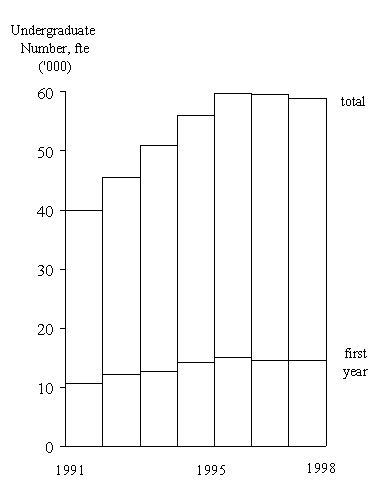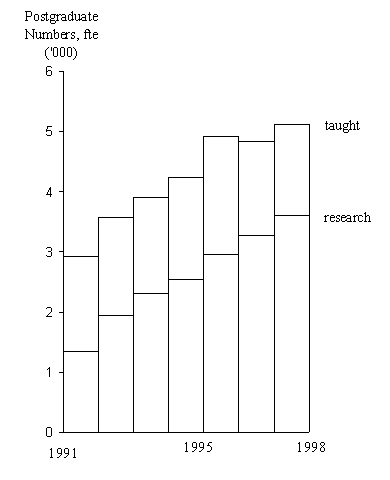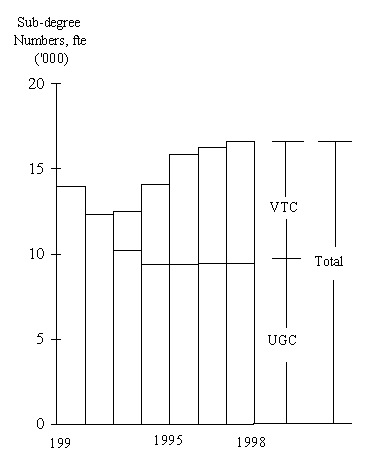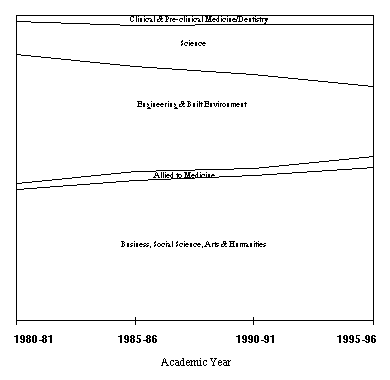Chapter 8: Expansion since 1989
| 8.1 |
On 5 September 1989 the Secretary for Education and Manpower placed before Executive Council an education strategy for the 1990s. In relation to the tertiary sector it recommended:
| ||||
| 8.2 | Subsequently, on 19 October 1989, the SEM wrote to the Chairman, UGC, asking the Committee to formulate proposals for the expansion, taking into account the plans of the VTC and Hong Kong's medium-term manpower requirements. The UGC's primary concern was, of course, the provision of the government's required number of first-year first-degree (FYFD) places. It adopted a three-pronged approach. First, the numbers in existing institutions would be increased. Second, the proportion of undergraduate places in the then polytechnics would be raised from about half to 65%. Third, Lingnan College would be assumed by the UGC and turned into a degree-awarding institution. | ||||
| 8.3 | The UGC recommends funding to its institutions on a triennial basis, and at the time of the government's request was in the middle of the triennium 1988-91. The government's target date for achieving 15,000 FYFD places (subsequently reduced to 14,500 in the light of revised population figures following the 1991 census) was the academic year 1994-5. The Committee believed that the whole of the quadrennium 1991-95 would be needed for the expansion but, partly because it was engaged in developing a more cost-effective funding methodology which could not be available for the beginning of that period, preferred to have a single grant year of 1991-92 and a triennium 1992-95. | ||||
| 8.4 | The expansion of FYFD places and the consequent growth in total undergraduate numbers is shown in Figure 8.1 (actuals 1991-96, planned 1996-98). It was subsequently decided to hold the planned 1994-95 undergraduate intake of 14,500 throughout the 1995-98 triennium, so the expansion of places for entrants from the schools ceased in 1994-95. | ||||
Figure 8.1 Expansion of FYFD Places and Growth in Undergraduate Numbers | |||||
 | |||||
| |||||
| The detailed figures for individual institutions for the period 1991-98 can be found in our Interim Report. Partly because of worries about the supply of well qualified matriculants and partly because of unfamiliarity with the new JUPAS system for admissions (see paragraphs 7.5 and 7.6), the institutions in fact over-enrolled first year undergraduates by 5.7% and 9.8% in 1991-92 and 1992-93. In 1993-94 and 1994-95 they were much closer to target with variance of 1.6% and - 1.7%. | |||||
| 8.5 | The government had very clear views on desirable undergraduate numbers. As far as postgraduates were concerned, the arguments were more complex and sometimes conflicting. We devoted paragraphs 12 to 15 of our Interim Report to the issues involved and will not repeat them here. After much consideration, the very substantial growth shown in Figure 8.2 was recommended by the Committee and accepted by government (see conspectus of Section F for the triennium 1995-98). | ||||
Figure 8.2 Growth in Postgraduate Student Numbers | |||||
 | |||||
| |||||
| The detailed figures for individual institutions will be found in our Interim Report. In fact, the institutions over-enrolled taught postgraduates slightly throughout the period 1991-95 but, after substantial over-enrollment (+13%) in 1992-3, research student numbers fell below target (-7%) in 1994-5. | |||||
| 8.6 | The government's proposals for expansion (paragraph 8.1) envisaged some movement of sub-degree work from the then polytechnics to the new technical colleges under the aegis of the VTC. The growth and change in provision is shown in Figure 8.3. | ||||
Figure 8.3 Provision of Sub-degree Course | |||||
 | |||||
| |||||
| 8.7 | The expansion of the UGC component of the higher education system during the quadrennium 1991-95 did not take place uniformly across disciplines. In terms of total fte student numbers, engineering and the built environment declined from 25% to 22%, but science increased from 18% to 21%. In fact, engineering and the built environment took no part in the expansion, with fte student numbers remaining stable at about 12,000, whereas science increased from 8,500 to 12,500, mainly in biological areas. These changes were continuations of longer term trends, as shown in Figure 8.4. As far as engineering is concerned, there was compensating growth in the Hong Kong Technical Colleges. | ||||
Figure 8.4 Distribution of Student Population (hc) | |||||
 | |||||
Source : UGC Secretariat | |||||
| 8.8 | The growths in student numbers which we have noted in the preceding paragraphs necessarily required increases in both recurrent and capital funding. The recurrent grant to the UGC institutions and the Technical Colleges rose from HK$4,600m in 1991-92 to HK$8,200m in 1994-95, a real terms growth of 32%. Within these totals the increase in research activity implied by the growth in numbers of academic staff and of research students during the expansion and by the increasing research culture in the institutions required a larger subvention to the Research Grants Council. Its funding increased from HK$100m in 1991-92 to HK$260m in 1994-95. Capital provision to the UGC institutions and the Technical Colleges, which totalled HK$7,300m during the 1991-95 quadrennium, was ten times larger in real terms than in any previous four year period. | ||||
| 8.9 | It is important to remember that the government's plans for the expansion of higher education were not confined to the UGC and VTC institutions. The Open Learning Institute, founded in 1989, was gathering momentum, and the Hong Kong Institute of Education was formally functioning from September 1994. The Academy for Performing Arts was also still growing, albeit more slowly. In 1994-95 the recurring cost of the OLI, HKIEd and APA was about 8% of that of the UGC institutions and the Technical Colleges. As well as growing in the government subvented sector, higher education was increasing post-1989 through private and charitable provision, particularly in the areas of CPE and courses from extra-territorial institutions. | ||||